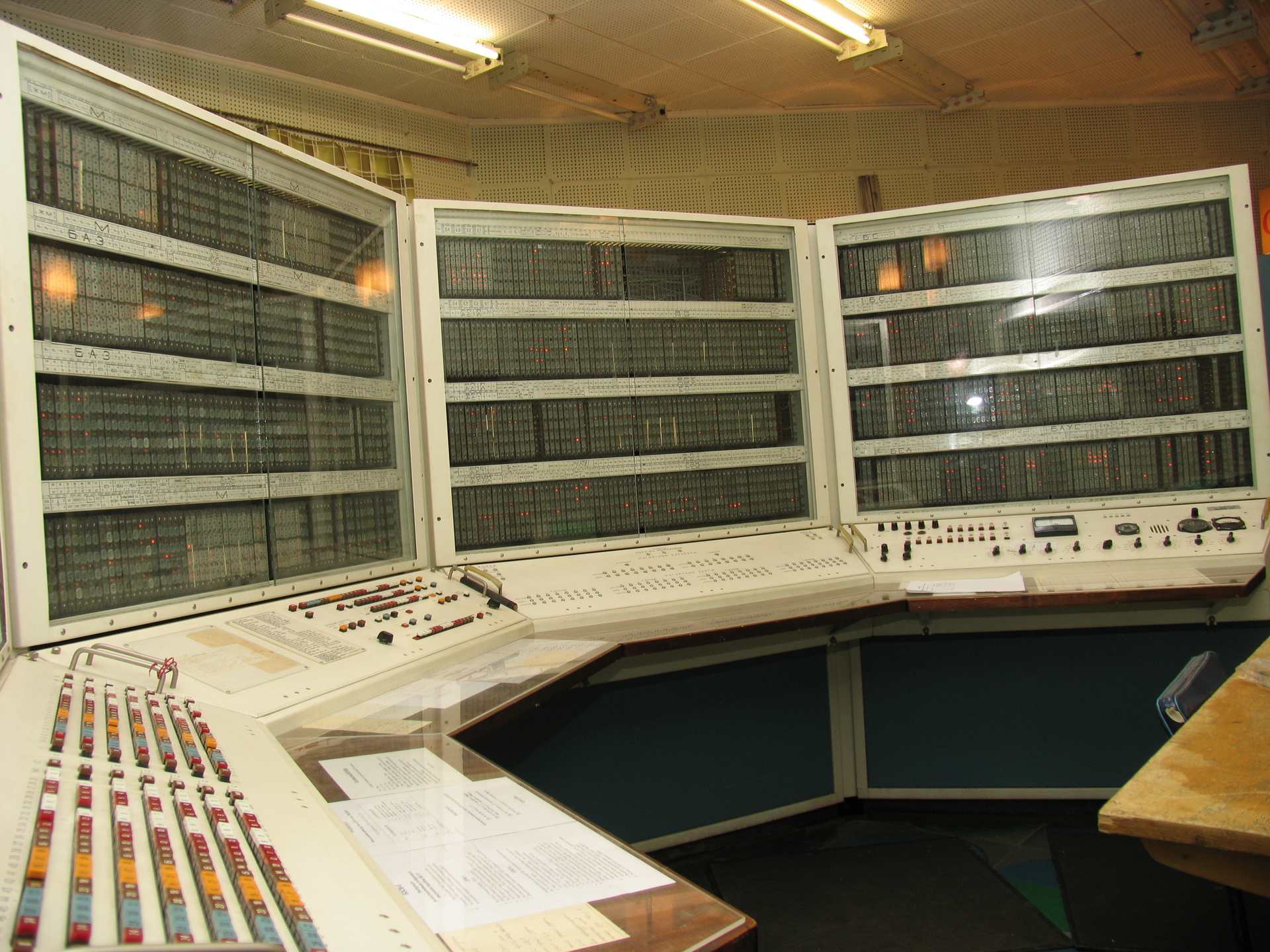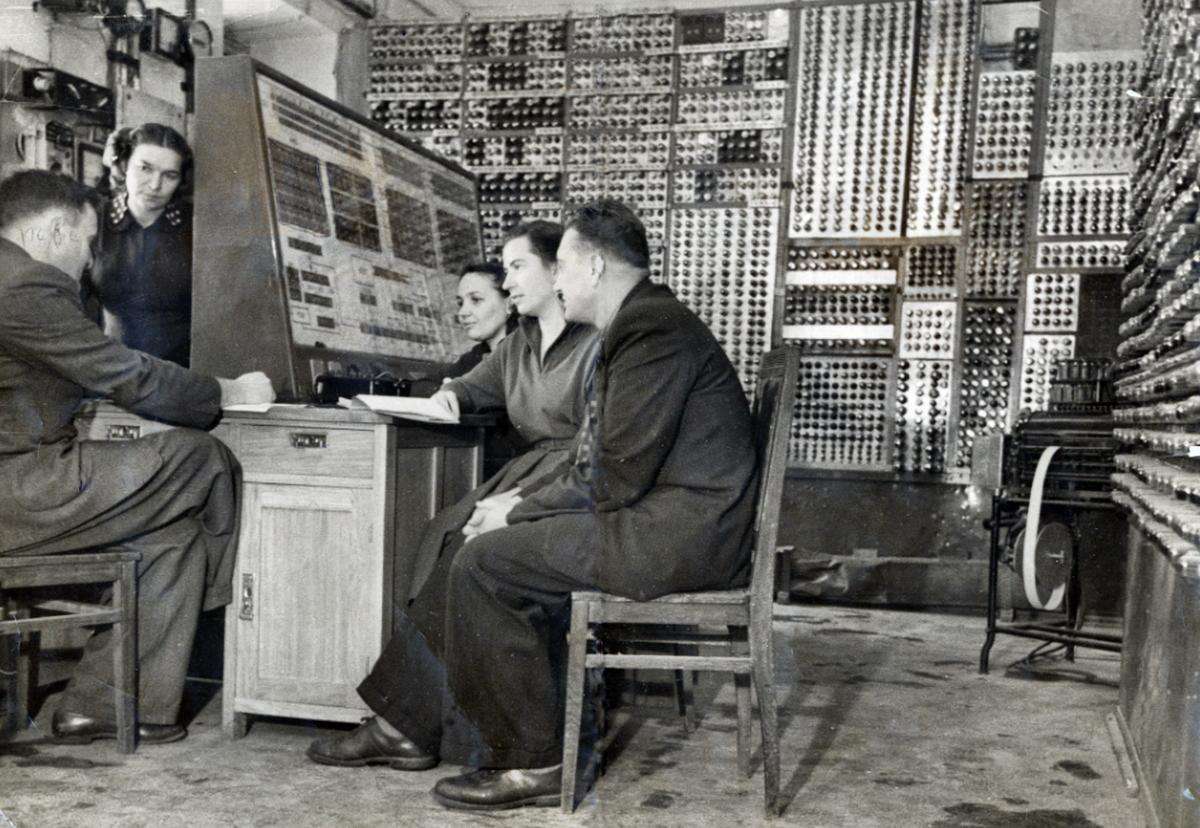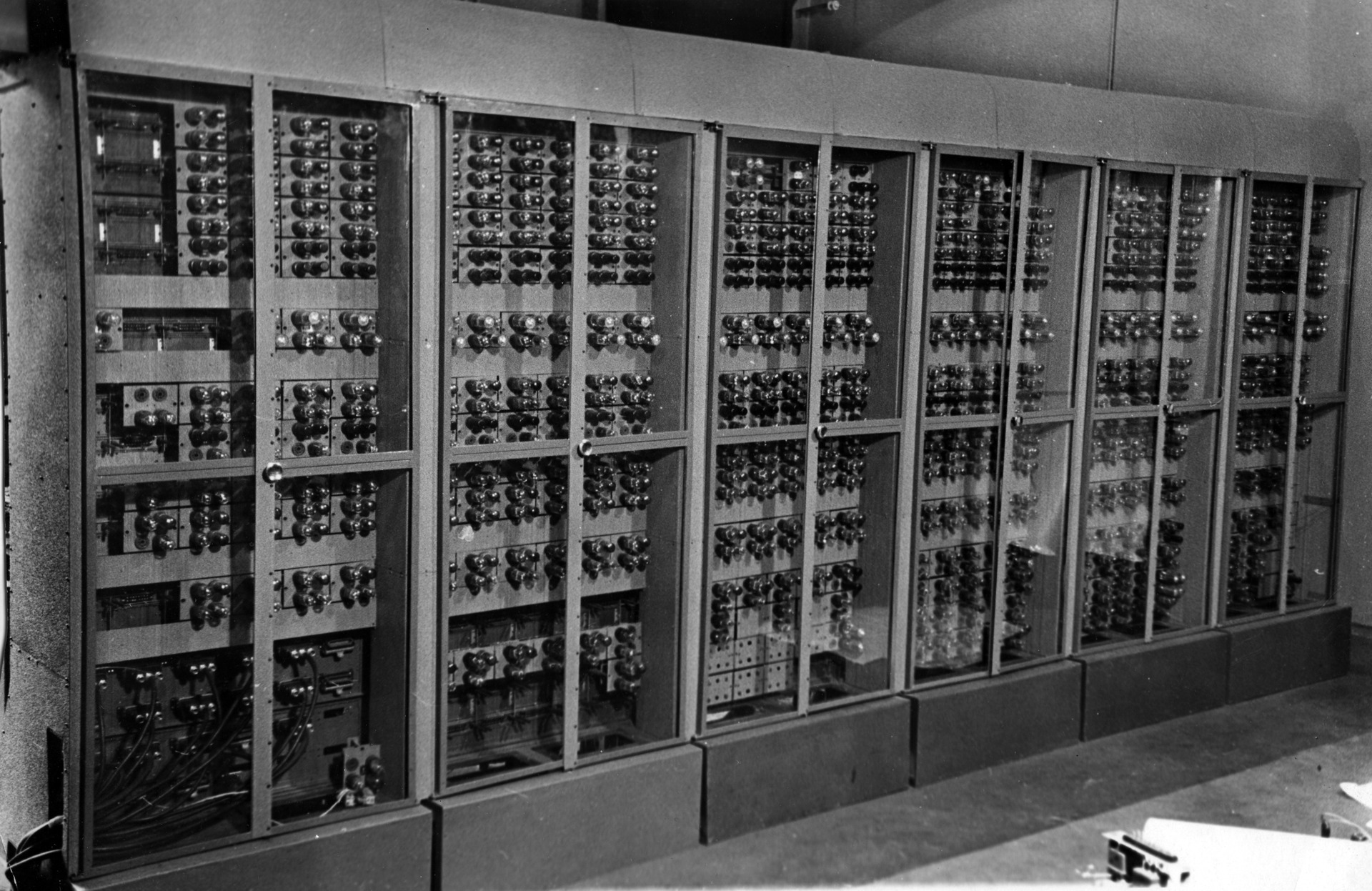Looking Back: The History of BESM
The history of computation goes into the distant past. Mankind had to spend more than one century to create the first electronic computer. Undoubtedly - this is one of the greatest discoveries of the 20th century, the start that allowed humanity to move forward in the world of information technology.

Until 1950, relay computers dominated, which were unreliable in calculations and very large in size. Vacuum and tube computers came to replace the relay. By right, the first electronic computer can be called the American ENIAC. The car had enormous data: 18,000 electron tubes, an area of 90 × 15 m 2 , weighed 30 tons and consumed 150 kW. And if in America and Europe, new computers were actively being created, in particular, with the Neimov type of memory, then in the USSR the process was slightly delayed.
')
So, in 1950, the first Soviet computer - MESM (small electronic counting machine) was created in the Kiev Laboratory of Modeling and Computer Engineering of the Institute of Electrical Engineering of the USSR Academy of Sciences under the leadership of academician S. A. Lebedev. It was a real breakthrough - Lebedev applied the principle of parallel word processing. Subsequently, the active structure of the first generation BESM-1 began (a large electronic counting machine).

The development of the BESM-1 was completed in 1952. The car had 2,000 electron tubes and a speed of 8,000 sp / s. The system of representation of numbers in the machine is binary, taking into account the orders, in the form of floating-point numbers. The range of numbers with which the machine operates is approximately from 9 to 109. The machine command system includes 9 arithmetic operations, 8 code transfer operations, 6 logical operations, 9 control operations. The total amount of RAM was 1024 bit words. Power consumption - 35 kW.

In 1953, the Soviet BESM-1 was the fastest computer in Europe, second only to IBM 701, which, in particular, was a huge commercial success.
BESM-1 was a machine capable of solving complex mathematical problems, replacing thousands of calculations. The machine has undoubtedly made a huge contribution to the development of atomic energy and space exploration. In the 1950s, many more Soviet computers were created, such as Minsk, the Urals, the Dnieper, the World, etc., but they were significantly inferior in performance to the BESM-1.
In the late 1950s, the boom of transistor computers began, which by their characteristics were far ahead of the tube ones. In England in 1958, a transistor computer was released - Elliot-803, in Germany - Simens-2002, in Japan - H-1. In the USSR, Setun became the first transistor computer. As for the BESM series, for the first time, transistors were used at BESM-6, but more on that later. At the same time, the first programming languages Algol and Fortran were created to facilitate the use of the machine.

After the success of BESM-1, it was decided to create an improved version for mass production. So, in 1958, BESM-2 was born. A total of 67 cars were produced in the period from 1958 to 1962 under the leadership of the ITMiVT team and the Volodarsky plant. According to reliable facts with the help of BESM-2, the trajectory of the unmanned Soviet rocket to the moon was calculated.
The main characteristics of the BESM-2 are similar to its predecessor. The car had 4000 electronic lamps, and the speed was increased to 20,000 op./c., And RAM to 2024 bit words.

In addition to the BESM-2, but based on the BESM-1, a serial computer, the M-20, was created, which was serially developed from 1955 to 1958. At the time of the development of the M-20 was the fastest computer in the world and had 20,000 op. / C. A total of 64 cars were produced.
BESM-3M was designed by young and talented ITM & T engineers. It was a small model that repeated the structure of the M-20 and later became the basis for the serial BESM-4.
If it were not for one cartoon, then BESM-4 could be called just a good computer. It was based on the element base - transistors and had a good performance (up to 40 000 operations per second). However, IBM at that time produced more decent samples.
BESM-4 completely inherited the architecture of the M-20 and had RAM - 4156 bit words. The machine has been serially produced since 1965, a total of 30 copies were produced. For BESM-4, there were at least 3 different compilers from the Algol-60 language, a Fortran compiler.

Probably, someone heard about the cartoon "Kitty . " It was quite short, and the movement of the cat's silhouette was shown in it. The whole point is that the motion was modeled by a system of second-order differential equations on the BESM-4. The frames of the cartoon were created by printing BESM-4 symbols on paper with the help of ADC-128. Therefore, it is safe to say that BESM-4 is directly related to the creation of one of the first commercials using computer animation.
The legendary BESM-6 certainly occupies a special place in the domestic computer industry. The principles laid down in its structural organization are still relevant. These computers are still used in research institutes to solve the most complex and important tasks.
BESM-6 was developed by a group of engineers led by S.A. Lebedeva in 1965, went into production in 1968. A total of 367 models were released. BESM-6 is the first supercomputer designed on the elemental base of the second generation.

The main goal of the BESM-6 was to create a fast-acting, relatively inexpensive serial machine that could meet all modern requirements of automation and programming. As the results show, the task was completed.
BESM-6 has decent technical indicators:
For BESM-6, there were many implementations of the programming languages that were popular at that time (for the Dubna monitor system), such as: Algol, Fortran, Pascal, APL, Lisp, Planer, etc. character encoding in BESM-6 and the command system is as follows.
On the basis of the BESM-6 were created known computers on integrated circuits of the Elbrus series. In the second half of the 80s, a 64-bit machine BESM-6 (Elbrus-B) was developed, including its own command system and two modes of compatibility with BESM.
On the basis of the BESM-6 was created a test emulator .
Certainly, the BESM series of computers served the development of the Soviet computer school. If you look at history, then we can say that in 1950–1960, the USSR was on a par with America in all plans, including computerization. BESM were worthy competitors to American IBM, and who knows how events could have turned if not for the fatal mistake made in 1967 by the USSR government. According to many experts, that very year was a turning point after the development of the EU-series of computers began.

Began a full copy of Western technology IBM. Thus, in the second half of the 80s, the release of personal EC-based computers (EU-1840, EU-45 and 55) on processors like Intel began in Minsk. However, the microprocessor production technology did not allow to go beyond the level of Intel 286. After that, the Soviet computer industry began to decline. Many factories were closed, and teams of scientists were dispersed. But the story does not change, and now BESM is very much appreciated among fans of Soviet computers.

Until 1950, relay computers dominated, which were unreliable in calculations and very large in size. Vacuum and tube computers came to replace the relay. By right, the first electronic computer can be called the American ENIAC. The car had enormous data: 18,000 electron tubes, an area of 90 × 15 m 2 , weighed 30 tons and consumed 150 kW. And if in America and Europe, new computers were actively being created, in particular, with the Neimov type of memory, then in the USSR the process was slightly delayed.
')
So, in 1950, the first Soviet computer - MESM (small electronic counting machine) was created in the Kiev Laboratory of Modeling and Computer Engineering of the Institute of Electrical Engineering of the USSR Academy of Sciences under the leadership of academician S. A. Lebedev. It was a real breakthrough - Lebedev applied the principle of parallel word processing. Subsequently, the active structure of the first generation BESM-1 began (a large electronic counting machine).

BESM-1
The development of the BESM-1 was completed in 1952. The car had 2,000 electron tubes and a speed of 8,000 sp / s. The system of representation of numbers in the machine is binary, taking into account the orders, in the form of floating-point numbers. The range of numbers with which the machine operates is approximately from 9 to 109. The machine command system includes 9 arithmetic operations, 8 code transfer operations, 6 logical operations, 9 control operations. The total amount of RAM was 1024 bit words. Power consumption - 35 kW.

In 1953, the Soviet BESM-1 was the fastest computer in Europe, second only to IBM 701, which, in particular, was a huge commercial success.
BESM-1 was a machine capable of solving complex mathematical problems, replacing thousands of calculations. The machine has undoubtedly made a huge contribution to the development of atomic energy and space exploration. In the 1950s, many more Soviet computers were created, such as Minsk, the Urals, the Dnieper, the World, etc., but they were significantly inferior in performance to the BESM-1.
BESM-2 and BESM-3M
In the late 1950s, the boom of transistor computers began, which by their characteristics were far ahead of the tube ones. In England in 1958, a transistor computer was released - Elliot-803, in Germany - Simens-2002, in Japan - H-1. In the USSR, Setun became the first transistor computer. As for the BESM series, for the first time, transistors were used at BESM-6, but more on that later. At the same time, the first programming languages Algol and Fortran were created to facilitate the use of the machine.

After the success of BESM-1, it was decided to create an improved version for mass production. So, in 1958, BESM-2 was born. A total of 67 cars were produced in the period from 1958 to 1962 under the leadership of the ITMiVT team and the Volodarsky plant. According to reliable facts with the help of BESM-2, the trajectory of the unmanned Soviet rocket to the moon was calculated.
The main characteristics of the BESM-2 are similar to its predecessor. The car had 4000 electronic lamps, and the speed was increased to 20,000 op./c., And RAM to 2024 bit words.

In addition to the BESM-2, but based on the BESM-1, a serial computer, the M-20, was created, which was serially developed from 1955 to 1958. At the time of the development of the M-20 was the fastest computer in the world and had 20,000 op. / C. A total of 64 cars were produced.
BESM-3M was designed by young and talented ITM & T engineers. It was a small model that repeated the structure of the M-20 and later became the basis for the serial BESM-4.
BESM-4
If it were not for one cartoon, then BESM-4 could be called just a good computer. It was based on the element base - transistors and had a good performance (up to 40 000 operations per second). However, IBM at that time produced more decent samples.
BESM-4 completely inherited the architecture of the M-20 and had RAM - 4156 bit words. The machine has been serially produced since 1965, a total of 30 copies were produced. For BESM-4, there were at least 3 different compilers from the Algol-60 language, a Fortran compiler.

Probably, someone heard about the cartoon "Kitty . " It was quite short, and the movement of the cat's silhouette was shown in it. The whole point is that the motion was modeled by a system of second-order differential equations on the BESM-4. The frames of the cartoon were created by printing BESM-4 symbols on paper with the help of ADC-128. Therefore, it is safe to say that BESM-4 is directly related to the creation of one of the first commercials using computer animation.
BESM-6
The legendary BESM-6 certainly occupies a special place in the domestic computer industry. The principles laid down in its structural organization are still relevant. These computers are still used in research institutes to solve the most complex and important tasks.
BESM-6 was developed by a group of engineers led by S.A. Lebedeva in 1965, went into production in 1968. A total of 367 models were released. BESM-6 is the first supercomputer designed on the elemental base of the second generation.

The main goal of the BESM-6 was to create a fast-acting, relatively inexpensive serial machine that could meet all modern requirements of automation and programming. As the results show, the task was completed.
BESM-6 has decent technical indicators:
- speed - about 1 million operations / s .;
- RAM capacity - from 32 to 128 thousand words;
- clock frequency - 9 MHz;
- element base - 60 thousand transistors;
- multiplication time - 1.9 μs;
- division time - 4.9 µs;
- the execution time of logical bitwise operations is 0.5 µs.
For BESM-6, there were many implementations of the programming languages that were popular at that time (for the Dubna monitor system), such as: Algol, Fortran, Pascal, APL, Lisp, Planer, etc. character encoding in BESM-6 and the command system is as follows.
On the basis of the BESM-6 were created known computers on integrated circuits of the Elbrus series. In the second half of the 80s, a 64-bit machine BESM-6 (Elbrus-B) was developed, including its own command system and two modes of compatibility with BESM.
On the basis of the BESM-6 was created a test emulator .
Summing up
Certainly, the BESM series of computers served the development of the Soviet computer school. If you look at history, then we can say that in 1950–1960, the USSR was on a par with America in all plans, including computerization. BESM were worthy competitors to American IBM, and who knows how events could have turned if not for the fatal mistake made in 1967 by the USSR government. According to many experts, that very year was a turning point after the development of the EU-series of computers began.

Began a full copy of Western technology IBM. Thus, in the second half of the 80s, the release of personal EC-based computers (EU-1840, EU-45 and 55) on processors like Intel began in Minsk. However, the microprocessor production technology did not allow to go beyond the level of Intel 286. After that, the Soviet computer industry began to decline. Many factories were closed, and teams of scientists were dispersed. But the story does not change, and now BESM is very much appreciated among fans of Soviet computers.
Source: https://habr.com/ru/post/375421/
All Articles